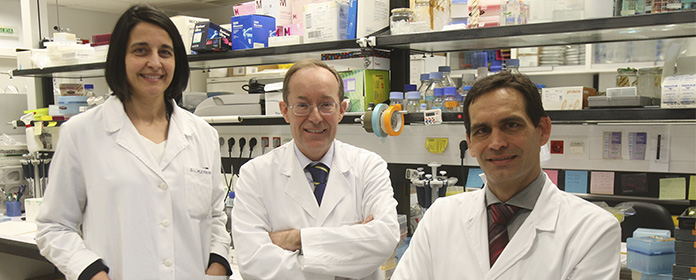New early diagnosis lung cancer molecular technique
Identification of epigenetic biomarkers for detection through a blood test of each patient's likelihood of developing this tumor

The Instituto de Investigación Sanitaria La Fe (IIS La Fe) has developed an innovative method for early diagnosis of lung cancer based on epigenetic biomarkers (molecular modifications which alter the activity of the genes without affecting the DNA sequence). The test is minimally invasive and more exact than the current systems, as it can detect the specific likelihood of each patient of developing this tumor through a blood test. The patent has been jointly registered by the Center for Applied Medical (CIMA) of the University of Navarra and the Bellvitge Biomedical Research Institute (IDIBELL).
"The combination of markers in this epigenetic model may help to improve the diagnosis of lung cancer and therefore lower the current high mortality rates", said the lead researcher of the project, Dr. Juan Sandoval, who is in charge of the Epigenetics Unit at the IIS La Fe. Moreover, said Dr. Luis Montuenga, director of the Biomarkers Laboratory of the CIMA Solid Tumor Program, "These molecular markers which are detectable in the blood may help to identify the presence of lung cancer in patients in whom other diagnostic tools do not give a conclusive answer".
In the research, funded by FEDER and the Instituto de Salud Carlos III, there has also been collaboration by researchers from the Instituto Catalán de Oncología, the Instituto de Investigación Sanitaria de Santiago and the Clínica Universidad de Navarra. The results have been published in the latest issue of Clinical Cancer Research, a scientific journal published by the American Association for Cancer Research.
Epigenetics as an ally in lung cancer diagnosisLung cancer is the main cause of mortality from cancer all over the world. The evolution of the patient is closely linked to the developmental stage of the tumor at the time of diagnosis. Unfortunately, most patients are diagnosed in late stages, when remedial treatment is no longer possible.
At present, cytology is the standard method for the diagnosis of this type of cancer in minimally invasive respiratory samples, but the method has low sensitivity. For this reason, the researchers decided to identify epigenetic biomarkers which would be clinically effective in the diagnosis of cancer, so as to improve the precision of the current technologies.
In order to identify new epigenetic biomarkers, the researchers carried out an integrated experimental method of the whole genome. Hundreds of patients at stage I, the earliest stage, were examined based on two independent sets of lung cancer data. The scientists managed to identify nine hypermethylated genes which were specific to primary lung cancer tumors, at an early stage. Of these, four (BCAT1, CDO1, TRIM58 and ZNF177) were selected for their diagnostic value.
The patented model allows for a combination of these four genes and generates a probability factor for the development of a specific cancer in each patient. The application of this epigenetic model is specially indicated in doubtful cases where a biopsy is now out feasible, or where the cytology is not conclusive.
This research has allowed us to confirm that the "minimally invasive epigenetic biomarkers are a promising tool for cancer diagnosis", says Dr. Sandoval, who also points out that "the combination of this highly sensitive and specific epigenetic model, together with standard clinical methodology may help to improve the diagnosis of lung cancer and therefore reduce the current mortality rate".
Main advantagesAmong the outstanding advantages of this new diagnostic method is the fact that, by means of a minimally invasive test, it allows for early diagnosis in patients at a greater risk of developing lung cancer. Moreover, it produces a continuous range of predictions between 100% and 0% (positive-negative). Thus, the oncologist will be able to act in different ways in accordance with the provisions, such as carrying out further tests in doubtful cases. In addition, this method identifies false negatives from cytology tests.
